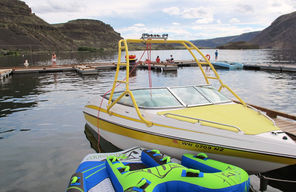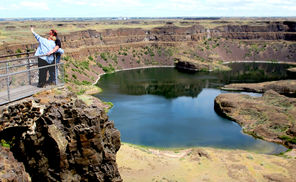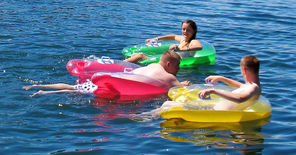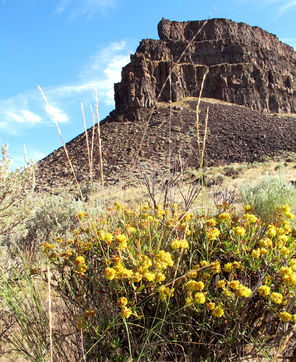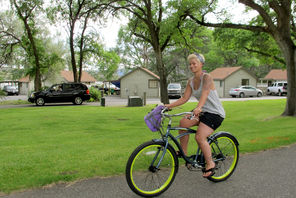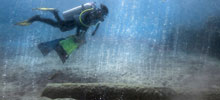Originally published July 27, 2013 at 7:04 PM | Page modified July 30, 2013 at 10:29 AM
Water, warmth and wonders at Sun Lakes/Dry Falls State Park
Site of stupendous ice-age floods is a desert oasis in Eastern Washington coulee country.
Seattle Times Outdoors editor
BRIAN J. CANTWELL/THE SEATTLE TIMES
Fun on the water is a big theme at Sun Lakes. Here, Park Lake sits in the shadow of soaring plateaus.
Brian J. Cantwell / The Seattle Times
Peggy and John Richardson, from Eugene, Ore., touring the Northwest on a motorcycle vacation, take a self-portrait photo at a viewpoint above Dry Falls. The cliffs were the site of a stupendous waterfall during the last ice age.
Brian J. Cantwell / The Seattle Times
Wildflowers along a trail frame Umatilla Rock at Sun Lakes/Dry Falls State Park.
Centennial celebration Saturday at Deception Pass State Park
Washington State Parks continue to celebrate their 100th year, and the next big event is an Aug. 3 party at Deception Pass State Park.
The 10 a.m.-4 p.m. Saturday event will include music all day, model sailboat races, park tours, crafts, food vendors, a Volkssport walk, and Junior Ranger and other activities for children. A ceremony with remarks by dignitaries is scheduled from 1 to 2 p.m. Festivities will be in the East Cranberry Lake area near the park’s main entrance, on the Whidbey Island portion of the park.
Events are free; a Discover Pass is required for parking.
If you go
Exploring coulee country
Where
Sun Lakes/Dry Falls State Park is off Highway 17, 6 miles west of Coulee City in Grant County; 194 miles by car from Seattle.
Park stays
For reservations and information on the state-managed campground: 888-CAMPOUT or
For reservations and information on the privately managed Sun Lakes Resort campground and cabins, inside the state park: 509-632-5291 or sunlakesparkresort.com
Food
Sun Lakes Resort has a small grocery and a walk-up snack bar/cafe.
Traveler's tips
• Occasional heavy winds are common in the coulees, so campers should be prepared. Stake down your tent.
• Along trails, expect wildflowers such as arrowleaf balsamroot and lupine in spring. Watch for rattlesnakes and poison ivy throughout the park.
• The park takes in Sites 36 and 37 on the Coulee Corridor map of Audubon Washington’s Great Washington State Birding Trail. See wa.audubon.org/great-washington-state-birding-trail
More information
Dry Falls Visitor Center: 509-632-5214
![]()
• This is the fifth park profile in our series on Washington state parks, in observance of the park system’s centennial. Find more park stories at seattletimes.com/travel
SUN LAKES/DRY FALLS STATE PARK, Grant County — Where else in the state of Washington can you go for a seven-minute hike and witness the results of an underwater tornado?
I was walking in the park’s 4,027-acre sagebrush landscape along a 19th-century trail used to take cattle from Oregon to the Cariboo Mine in British Columbia. But suddenly I was immersed in a history much older, as I stood before a rocky pothole big enough to swallow a suburban house.
This was an artifact of the ice-age floods of some 15,000 years ago, when mammoth ice dams in Montana broke and the waters of a giant lake — with 500 cubic miles of water — swept across Northern Idaho and Eastern Washington and scoured out the dramatic coulees we see today. The raging floodwaters were hundreds of feet deep.
“The potholes were created when the floodwaters created a vortex, or underwater tornado, that would burrow out these holes in basalt rock,” said Chris McCart, an interpretive specialist at the nearby Dry Falls Visitor Center. “They’re 50 feet deep or more and look like someone cut them out with a cookie cutter.”
Just “upstream” from where I stood, Dry Falls itself was once the site of, well, a sight to behold. Here, during those floods, raging waters dropped more than 400 feet over cliffs 3.5 miles wide — more than twice as high and three times as wide as Niagara Falls.
Sun Lakes, a series of lakes in the coulee bottom below Dry Falls, has been a vacation playground for decades, drawing Puget Sounders hungry for desert heat. And while some visitors may be just as happy swimming, paddling and water skiing in perfect ignorance of this place’s natural history, combine the educational opportunities with fun in the sun and you get a state park well worth a visit.
What makes it a gem
All of the above. And there’s so much to do:
Get up early for a preheat bike ride along Park Lake Trail, a 3-mile round-trip along a closed roadway bordering the park’s biggest lake, and watch the rising sun light the coulee’s fluted walls.
Or take the 2.6-mile loop trail around a monolith called Umatilla Rock, seen from the park’s campground if you look for a stone formation that looks like a man playing a grand piano. This trail is like a geologist’s candy store: a showcase of soaring pinnacles, inexplicable “snowballs” of rock the size of a camping yurt and rocky protrusions pointing skyward like the prow of a sinking ship. The sweet and smoky scent of sagebrush perfumes the air. A line I never thought I’d write: The rising sun brings out the pretty chartreuse of huge patches of lichen on the rocky cliffs.
This is also a place layered in history. Before the ice-age floods, this area hosted life of all kinds until a massive lava flow, one of the largest ever recorded on Earth, covered the region. Just south of the state park a fossilized mold and a few bones of a small rhinoceros were found in 1935 — the mold preserved in basalt overlaying a thin sand bed. Nearby are Lake Lenore Caves, shallow recesses in cliffs reached by a challenging 10-minute hike, where Native American hunters once sheltered.
What you won’t find everywhere
Few state parks are quite so devoted to fun.
Not many state parks have a nine-hole golf course, as does Sun Lakes. It’s named for Vic Meyers, a one-time Seattle bandleader who served as the state’s lieutenant governor from 1932 to 1952 and who championed the park’s creation.
Not many parks have a large private resort within its bounds, such as Sun Lakes Resort, operated under lease from the state and including its own separate RV park (with 27 new sites nearing completion) as well as a large collection of rental cabins, plus miniature golf, a water-balloon-fight concession, grocery, snack bar, marina and a fleet of rental rowboats, pedal boats, water bikes and more.
Fishing and water sports are big here, as is just relaxing around a campsite playing cards, as I found three generations of a Western Washington family doing on a recent visit.
“I’ve been coming here 25 years for the fishing in the spring,” said Pat Jacobs, the 78-year-old grandfather, from Snohomish, as he dealt another game of Hearts. “Fishing can be really great.”
Swimming is the big draw, insisted his grandson, 16-year-old Riston Ramirez, from Carnation. “There are cliffs you can jump off at Deep Lake,” he confided. (The park strongly discourages it, including signs warning that jumpers have been injured or killed. But many young people do it, judging by videos found on YouTube.)
Water skiing at nearby Banks Lake is another draw, or playing golf at the little golf course, “though it’s not much of a course,” laughed Laurell Ramirez, Riston’s mom.
Not to be missed
• The Dry Falls Visitor Center and viewpoint is 1.7 miles north of the park’s main entrance off Highway 17. Built in the 1960s, the center is showing its age, but displays are informative and a recently made short film, produced with Central Washington University, is an excellent introduction to the area’s natural history. Enjoy the view of the cliffs and swooping swallows and swifts.
• If you want more peace and quiet than you’ll find around Park Lake, which borders the resort and campgrounds, drive or bike the park’s little-used back road (along which I saw mule deer and a scurrying marmot) 2.5 miles to Deep Lake. Powerboats are limited to 5 mph there.
• If you’ve never seen Grand Coulee Dam, take the 45-minute drive up the highway to this largest hydropower producer in the United States. A visitor center is open daily and free tours are available of a pump-generating plant — first-come first-served (usbr.gov/pn/grandcoulee).
Where to lay your head
The park has campgrounds — some managed by park rangers, plus the RV park managed by the private resort — along with a variety of accommodations rented out by Sun Lakes Resort. The campgrounds are fairly basic: Tenters will likely be pitching their shelters on gravel in the state campground (where campsites cost $23-$37 a night in peak season), though the private campground ($36-$42 a night in peak season) allows tents on grassy areas. Many sites have shade trees, but don’t expect privacy between campsites. The attraction here is more the lakes, sunshine and natural wonders than the camping.
For a roof over your head, the resort has 65 units, including small and rather elderly lakeside cabins (Units 19 to 30 have views, others are blocked by vegetation), poolside cabins (there is a small swimming pool, about 36 feet long), two-bedroom mobile homes and a few new lakeview cabins. Summer rates (through Sept. 2) range from $101 to $199 per night. Book far in advance for peak-season weekends.
Just for fun
• Play a round of golf at the nine-hole course ($13-$15 per person); miniature golf ($4 per person); or try “Water Wars” ($2 per bucket of water balloons). Rent a rowboat ($5 per hour), pedal boat ($10 per hour) or aqua cycle ($15 per hour).
• Bring binoculars and see how many types of birds and other creatures you can spot. Birds common to the park include quail (bobbing through the campground), goldfinches (flitting everywhere), golden eagles (soaring over cliffs), wild turkeys and more.
• Bring a bicycle.
Brian J. Cantwell: bcantwell@seattletimes.com. Blogging at blogs.seattletimes.com/northwesttraveler. On Twitter: @NWTravelers





